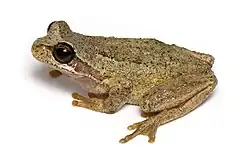| Pelodryadidae[1] | |||
| Günther, 1858[2] | |||
 Przedstawiciel rodziny – Litoria ewingii | |||
| Systematyka | |||
| Domena | |||
|---|---|---|---|
| Królestwo | |||
| Typ | |||
| Podtyp | |||
| Nadgromada | |||
| Gromada | |||
| Podgromada | |||
| Rząd | |||
| Podrząd | |||
| Rodzina |
Pelodryadidae | ||
| Typ nomenklatoryczny | |||
|
Pelodryas Günther, 1858 | |||
| Synonimy | |||
| |||
| Podrodziny | |||
| |||
Pelodryadidae – rodzina płazów z rzędu płazów bezogonowych (Anura).
Zasięg występowania
Rodzaj obejmuje gatunki występujące w regionie australijsko-papuańskim[11].
Systematyka
Taksonomia
Przed 2016 rokiem klasyfikowana jako podrodzina rzekotkowatych; Duellman, Marion i Hedges (2016) podnieśli ją do rangi odrębnej rodziny[12].
W 2006 roku Frost i inni włączyli gatunki z rodzaju Nyctimystes i Cyclorana do Litoria[13]. Autorzy zaznaczyli jednak, że relacje pokrewieństwa pomiędzy Pelodryadinae nie zostały ostatecznie ustalone, co podkreślili nadając Cyclorana rangę podrodzaju, a Nyctimystes traktowane jest jako grupa gatunków.
Podział systematyczny
Do rodziny należą następujące podrodziny[11]:
- Litoriinae Dubois & Frétey, 2016
- Pelodryadinae Günther, 1858
Taksony o niejasnym pokrewieństwie i nieklasyfikowane w żadnej z podrodzin[11]:
- „Litoria” castanea (Steindachner, 1867)
- „Litoria” jeudii (Werner, 1901)
- „Litoria” louisiadensis (Tyler, 1968)
- „Litoria” multicolor Günther, 2004
- „Litoria” obtusirostris Meyer, 1875
- „Litoria” richardsi Dennis & Cunningham, 2006
- „Litoria” vagabunda (Peters & Doria, 1878)
Taksony nieprzypisane do żywej lub wymarłej populacji (nomina inquirenda)[11]:
- Hyla ocellata Péron, 1807
- Hyla rubeola Péron, 1807
- Hyla ianopoda Péron, 1807
- Hyla nebulosa Péron, 1807
- Hyla javana Ahl, 1926
Uwagi
Przypisy
- ↑ Pelodryadidae, [w:] Integrated Taxonomic Information System (ang.).
- ↑ A.L.C.G. Günther. On the systematic arrangement of the tailless batrachians and the structure of Rhinophrynus dorsalis. „Proceedings of the Zoological Society of London”. 26, s. 346, 1858. (ang.).
- ↑ L.J.F.J. Fitzinger: Systema reptilium. Fasciculus primus, Amblyglossae. Vindobonae: Braumüller et Seidel, 1843. (łac.).
- ↑ S.G. Mivart. On the classification of the anurous batrachians. „Proceedings of the Zoological Society of London”. 37, s. 294, 1869. (ang.).
- ↑ H.W. Parker. The Australasian frogs of the family Leptodactylidae. „Novitates Zoologicae”. 42, s. 12, 1940. (ang.).
- ↑ J.D. Lynch: Program. Final PhD Examination. Lawrence, Kansas: University of Kansas, 1969, s. 3. (ang.).
- ↑ J.M. Savage: The geographic distribution of frogs: patterns and predictions. W: J.L. Vial (red.): Evolutionary Biology of the Anurans: Contemporary Research on Major Problems. Columbia, Missouri: University of Missouri Press, 1973, s. 351-445. ISBN 0-8262-0134-2. (ang.).
- ↑ R.F. Laurent. Biogéographie et liaisons intercontinentales au course du Mésozoïque. „Mémoires du Muséum National d’Histoire Naturelle”. Série A, Zoologie. 88, s. 183, 1975. (fr.).
- ↑ H.G. Dowling & W.E. Duellman: Systematic Herpetology: A Synopsis of Families and Higher Categories. New York: HISS Publications, 1974, s. 1. (ang.).
- ↑ F. Bossuyt & K. Roelants: Anura. W: S.B. Hedges & S. Kumar (red.): The Timetree of Life. New York: Oxford University Press, 2009, s. 359. ISBN 978-0-19-953503-3. (ang.).
- 1 2 3 4 D. Frost: Pelodryadidae Günther, 1858. [w:] Amphibian Species of the World 6.0, an Online Reference [on-line]. American Museum of Natural History. [dostęp 2020-01-30]. (ang.).
- ↑ William E. Duellman, Angela B. Marion i S. Blair Hedges. Phylogenetics, classification, and biogeography of the treefrogs (Amphibia: Anura: Arboranae). „Zootaxa”. 4104 (1), s. 1–109, 2016. DOI: 10.11646/zootaxa.4104.1.1. (ang.).
- ↑ D.R. Frost, T. Grant, J. Faivovich, R.H. Bain, A. Haas, C.F.B. Haddad, R.O. de Sá, A. Channing, M. Wilkinson, S.C. Donnellan, Ch.J. Raxworthy, J.A. Campbell, B.L. Blotto, P.E. Moler, R.C. Drewes, R.A. Nussbaum, J.D. Lynch, D.M. Green & W.C. Wheeler. The amphibian tree of life. „Bulletin of the American Museum of Natural History”. 297, 2006. DOI: 10.5531/sd.sp.13. (ang.).